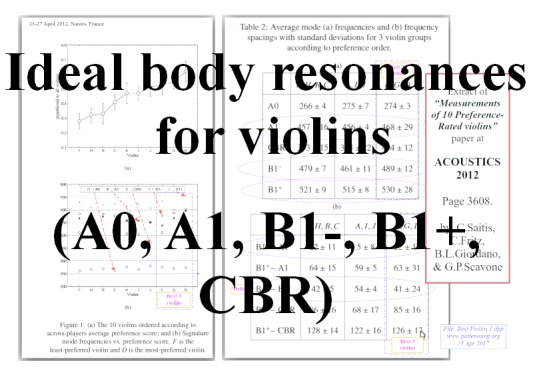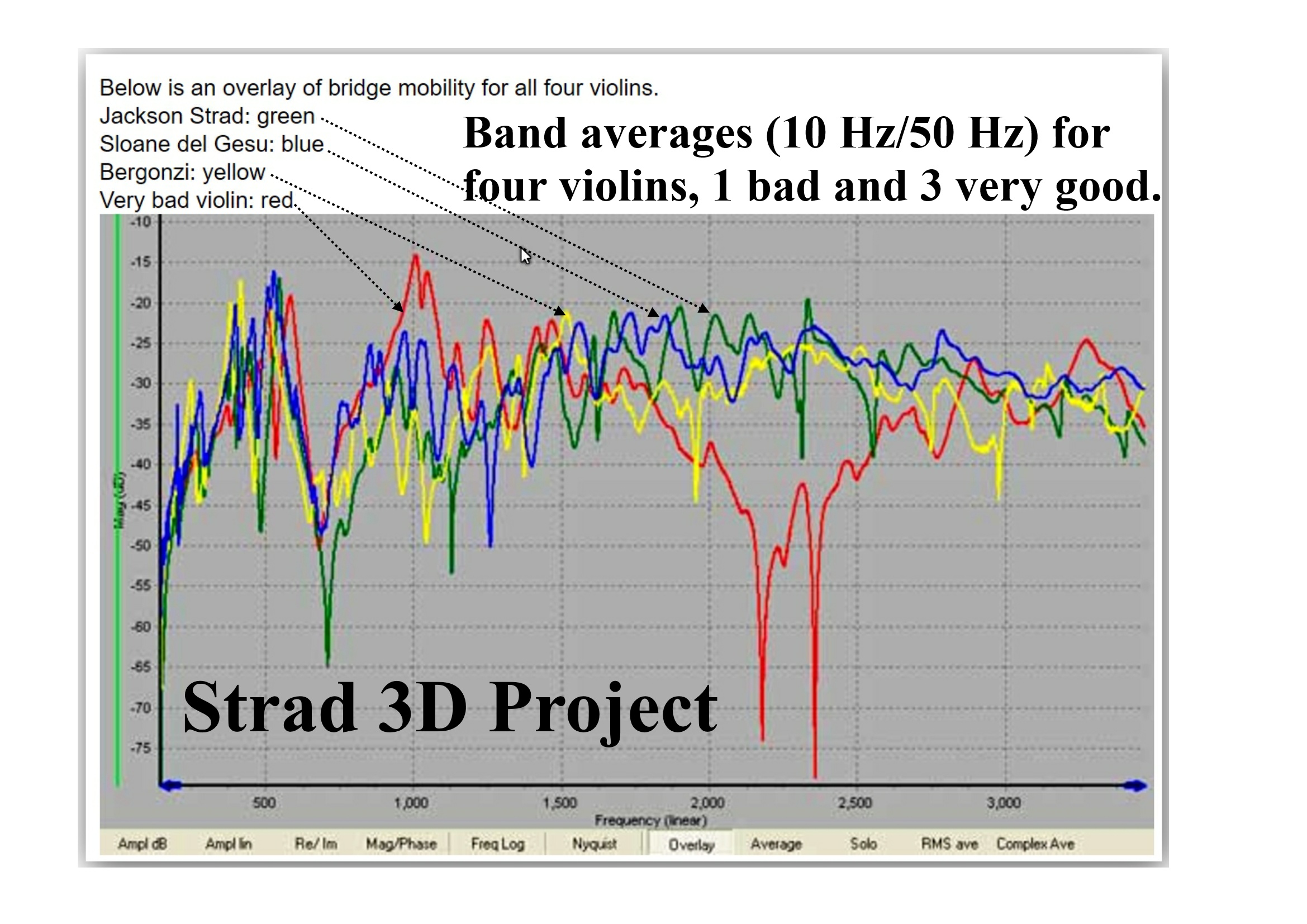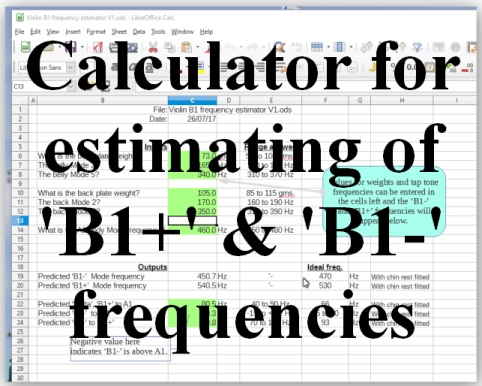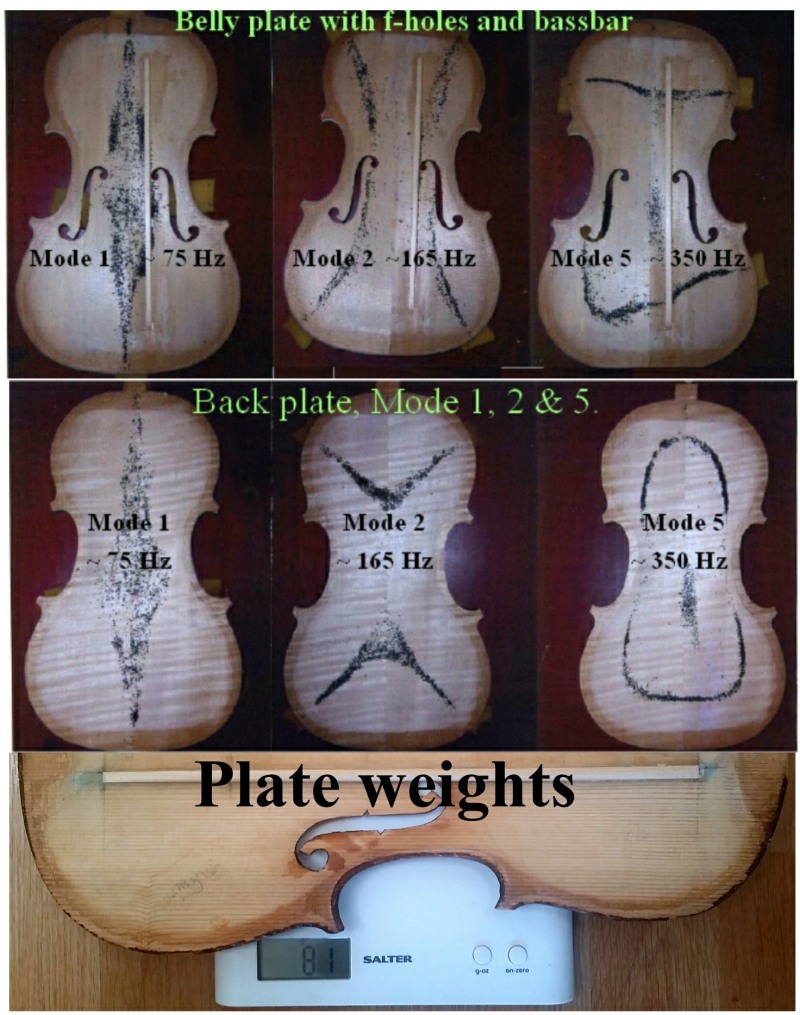|
Body resonance targets
There is a useful article available on the web on ‘ideal target body resonances’ titled “Measurements of 10 Preference-Rated violins” paper given at ACOUSTICS 2012 on (page 3608), written by C. Saitis, C. Fritz, B.L. Giordano, & G.P. Scavone.
If you click on the picture right it will bring up the data from that article for the key body resonances of the best 3 of the 10 good violins they tested for sound quality, as perceived by a group of expert listeners.

I’ve also extracted the data from Jo. Curtin’s ‘Strad’ article of July 2009 into a chart (click on the chart left) and the [LibreOffice or OpenOffice] spreadsheet made from it is here.
The Strad 3D Project gives us good information about the body resonances of 3 good Italian violins: one diagram from the site is extracted below, so click on it.
It shows the peaks of  the body modes that are best radiated from these violins. the body modes that are best radiated from these violins.
There is also helpful information in a “Probing the Secrets Of The Finest Fiddles” article from the Science Magazine, June 2010.
Carleen Hutchins recommended matching the B0 body resonance to the A0 (Helmholtz) resonance you have measured above. If it is at too high a frequency, reduce B0 by adding weight at the end of the fingerboard. For example, use blue-tack stuck under the end.
You can look at Jo Curtin’s “Good Vibrations” papers in the Strad or on his website to see where these key resonances are for some of the world's great violins! So if you want to copy one - you can try to copy the main body resonances too!
Ideally the tailpiece resonance, usually at about 125 to 135 Hz should be at half of A0 and B0.
Oberlin Acoustics has a glossary online of these key terms and abbreviations here
The article Mode tuning for the violin maker by by Carleen M. Hutchins and Duane Voskuil is rather an advanced paper, but if you can understand it, it covers all the basics on violin body resonances.
Now what do we do with this information on body resonances ?
Carleen M. Hutchins’ work showed that the difference or ‘delta’ between the frequencies ‘B1+’ and A1 dictate how a violin projects, and quoting from her CAS paper:
A1 AND B1 FREQUENCY RELATIONSHIPS: It has been found that the frequency spacing (delta) between the A1 cavity mode and the B1[+] body mode is critical to the overall tone and playing qualities, indicating whether a violin is suitable for soloists (delta 60-80 Hz), orchestra players (delta 40-60 Hz), chamber music players (delta 20-40 Hz), and below 20 Hz is easy to play but lacks power” (Hutchins 1989).
Amongst my many violins I’d say that it is so!
There are discussions among the experts on maestronet on just what the relationships are between  the plate tap tones, weights and thicknesses. It is complex . Anders Buen has come up with a useful relationship I have reproduced here, where he says: the plate tap tones, weights and thicknesses. It is complex . Anders Buen has come up with a useful relationship I have reproduced here, where he says:
I have developed a model (shown on the ‘Plate Tuning 4 Dummies’ page) that is based on the data from 25 violin samples. It follows each of the belly and back plates and their tap-tones right from the start of violin construction through to finished violins and the completed violin body resonances; all of these ~25 violins sound either good or very good.
Estimating B1+. Accuracy: sigma ~10 Hz.
>> Ideally ‘B1+’ is 60 - 90 Hz above A1.
A very important element in what a violin sounds like is just how far B1+ is above the A1 body (or rather internal air) resonance is, the true ‘Delta’ given above.
1) The data shows the most important factor for the ‘B1+’ frequency is
a) the back plate's Mode 2 frequency, and
b) the belly plate weight. A heavy belly plate reduces ‘B1+’.
2) The next most important things are:-
a) the back plate Mode 5,
b) the belly plate Mode 5 frequency, and
c) the back plate weight. A heavy back plate reduces B1+.
3) The least important things are the belly plate Mode 2 and Mode 5, and also the bass-bar height, although that affects the belly Mode 5.
This is explained in much more detail  on the ‘Plate Tuning 4 Dummies’ page. If you click on the frame right a small [Excel, OpenOffice or LibreOffice] spreadsheet will be downloaded allowing the estimation of the two violin body Mode B1 frequencies to be automated for you. You just input the plate tap tones and weights and the B1 frequencies are estimated for you. on the ‘Plate Tuning 4 Dummies’ page. If you click on the frame right a small [Excel, OpenOffice or LibreOffice] spreadsheet will be downloaded allowing the estimation of the two violin body Mode B1 frequencies to be automated for you. You just input the plate tap tones and weights and the B1 frequencies are estimated for you.
This can be opened on your mobile too using the Microsoft Office Excel program/app. Just the input cells are unlocked, allowing data input. OpenOffice and LibreOffice are free to download on Windows PC, and there are several Android mobile apps available too.
The back is often seen as the sound ’reflector’ to the belly’s ‘projector’, so do not take too much wood off this critical area between the C-bouts of the back plate, including the area of the channel next to the linings.
So by making or adapting the belly and back plates, with .....
- good arching,
- careful edge-work and edge thicknesses and
- well chosen tap tones (Modes 2 and 5) based on
- low plate weights - heavy plates need higher tap tones -
you can predict to an accuracy of ~10 Hz the key violin body resonances and therefore be confident that your violin will sound excellent!
|
